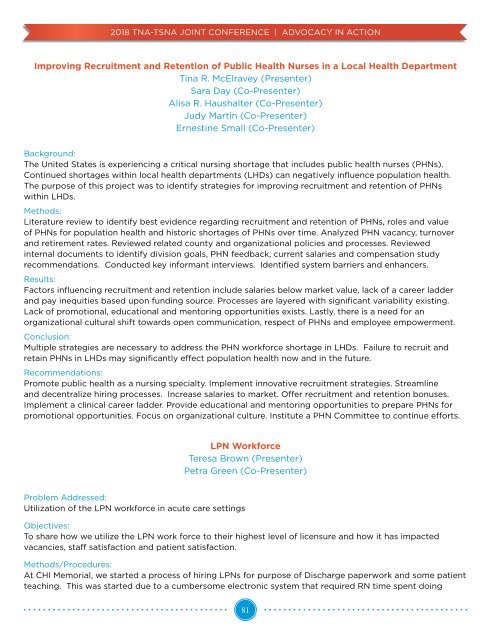2018 TNA and TSNA Joint Annual Conference
Create successful ePaper yourself
Turn your PDF publications into a flip-book with our unique Google optimized e-Paper software.
<strong>2018</strong> <strong>TNA</strong>-<strong>TSNA</strong> JOINT CONFERENCE | ADVOCACY IN ACTION<br />
Improving Recruitment <strong>and</strong> Retention of Public Health Nurses in a Local Health Department<br />
Tina R. McElravey (Presenter)<br />
Sara Day (Co-Presenter)<br />
Alisa R. Haushalter (Co-Presenter)<br />
Judy Martin (Co-Presenter)<br />
Ernestine Small (Co-Presenter)<br />
Background:<br />
The United States is experiencing a critical nursing shortage that includes public health nurses (PHNs).<br />
Continued shortages within local health departments (LHDs) can negatively influence population health.<br />
The purpose of this project was to identify strategies for improving recruitment <strong>and</strong> retention of PHNs<br />
within LHDs.<br />
Methods:<br />
Literature review to identify best evidence regarding recruitment <strong>and</strong> retention of PHNs, roles <strong>and</strong> value<br />
of PHNs for population health <strong>and</strong> historic shortages of PHNs over time. Analyzed PHN vacancy, turnover<br />
<strong>and</strong> retirement rates. Reviewed related county <strong>and</strong> organizational policies <strong>and</strong> processes. Reviewed<br />
internal documents to identify division goals, PHN feedback, current salaries <strong>and</strong> compensation study<br />
recommendations. Conducted key informant interviews. Identified system barriers <strong>and</strong> enhancers.<br />
Results:<br />
Factors influencing recruitment <strong>and</strong> retention include salaries below market value, lack of a career ladder<br />
<strong>and</strong> pay inequities based upon funding source. Processes are layered with significant variability existing.<br />
Lack of promotional, educational <strong>and</strong> mentoring opportunities exists. Lastly, there is a need for an<br />
organizational cultural shift towards open communication, respect of PHNs <strong>and</strong> employee empowerment.<br />
Conclusion:<br />
Multiple strategies are necessary to address the PHN workforce shortage in LHDs. Failure to recruit <strong>and</strong><br />
retain PHNs in LHDs may significantly effect population health now <strong>and</strong> in the future.<br />
Recommendations:<br />
Promote public health as a nursing specialty. Implement innovative recruitment strategies. Streamline<br />
<strong>and</strong> decentralize hiring processes. Increase salaries to market. Offer recruitment <strong>and</strong> retention bonuses.<br />
Implement a clinical career ladder. Provide educational <strong>and</strong> mentoring opportunities to prepare PHNs for<br />
promotional opportunities. Focus on organizational culture. Institute a PHN Committee to continue efforts.<br />
LPN Workforce<br />
Teresa Brown (Presenter)<br />
Petra Green (Co-Presenter)<br />
Problem Addressed:<br />
Utilization of the LPN workforce in acute care settings<br />
Objectives:<br />
To share how we utilize the LPN work force to their highest level of licensure <strong>and</strong> how it has impacted<br />
vacancies, staff satisfaction <strong>and</strong> patient satisfaction.<br />
Methods/Procedures:<br />
At CHI Memorial, we started a process of hiring LPNs for purpose of Discharge paperwork <strong>and</strong> some patient<br />
teaching. This was started due to a cumbersome electronic system that required RN time spent doing<br />
81

















